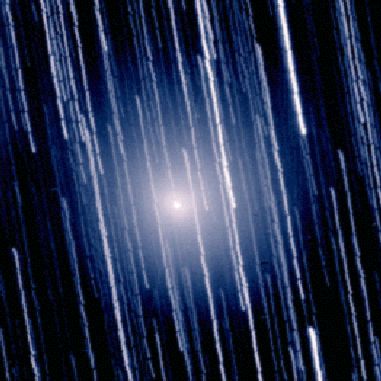Credit & Copyright: T. Puckett
(Puckett Observatory)
Explanation:
Star trails
streak this composite time exposure of
comet
Tempel-Tuttle recorded by Tim Puckett on January 26, 1998.
Then passing through the inner solar system on its
33 year orbit around the Sun,
Tempel-Tuttle brightened unexpectedly, but
binoculars or small telescopes
were still required to visually observe it.
Tempel-Tuttle is also called "the Leonid Comet" as the yearly
Leonid meteor shower
results when the Earth crosses this comet's orbital
plane and encounters a trail of
cometary dust.
So, while not rivaling spectacular naked-eye comets like
Hyakutake or
Hale-Bopp,
Tempel-Tuttle still puts on a show.
The Earth is
now approaching relatively
dense regions
of Tempel-Tuttle's orbiting debris trail, so
in the next few days,
skywatchers will be
searching for leonid meteors.
An extremely active meteor shower
is expected to be visible
over Europe and North America
in the early morning hours of
Tuesday, November 19,
despite interference from a glaring full moon.
1999 2000 2001 2002 2003 2004 2005 2006 2007 2008 2009 2010 2011 2012 2013 2014 2015 2016 2017 2018 2019 2020 2021 2022 2023 2024 2025 |
Yanvar' Fevral' Mart Aprel' Mai Iyun' Iyul' Avgust Sentyabr' Oktyabr' Noyabr' Dekabr' |
NASA Web Site Statements, Warnings, and Disclaimers
NASA Official: Jay Norris. Specific rights apply.
A service of: LHEA at NASA / GSFC
& Michigan Tech. U.
|
Publikacii s klyuchevymi slovami:
comet Tempel-Tuttle - comet - meteor shower - Leonids - kometa Tempelya-Tuttlya - komety - Leonidy - Meteornyi potok
Publikacii so slovami: comet Tempel-Tuttle - comet - meteor shower - Leonids - kometa Tempelya-Tuttlya - komety - Leonidy - Meteornyi potok | |
Sm. takzhe:
Vse publikacii na tu zhe temu >> | |
